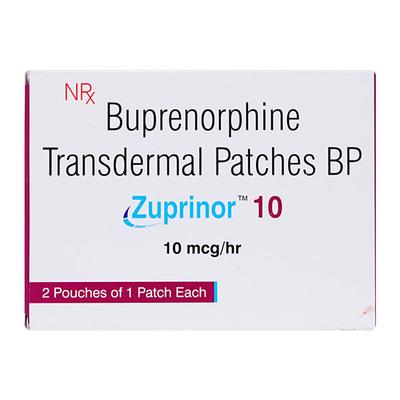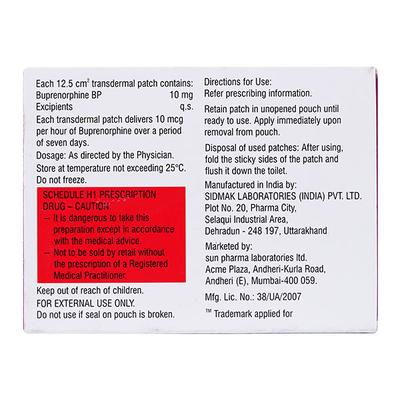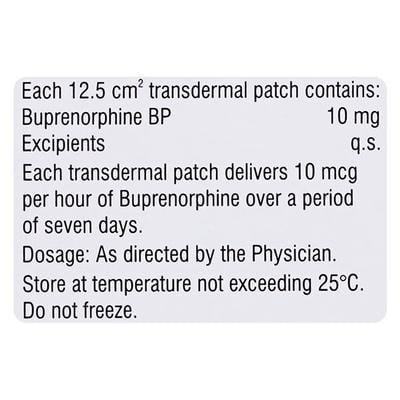

Netmeds First Membership
Quick Links
Introduction About ZUPRINOR 10 TRANSDERMAL PATCH
ZUPRINOR 10 TRANSDERMAL PATCH contains Buprenorphine which belongs to the group of medicines called Strong analgesics. It is used to provide relief from moderate long-lasting pain that requires the use of a strong painkiller in affected individuals.
Pain is an uncomfortable sensation in the body that stems from the activation of nervous system which generally occurs as an annoying or debilitating sensation generally characterized by symptoms such as as a sharp, dull, throbbing, pinching, stinging and/or burning sensation in affected individuals.
Avoid consumption of alcohol while using ZUPRINOR 10 TRANSDERMAL PATCH. This medicine is not recommended for use in patients with breathing problems, addiction to drugs and/or myasthenia gravis (condition that weakness muscles). Before using [GNKEYWORD], inform your doctor if you suffer from sleep apnoea (a breathing related sleep disorder), severe liver problems and/or kidney diseases.
ZUPRINOR 10 TRANSDERMAL PATCH is not recommended for use in pregnant and breastfeeding women which is also not recommended for use in children and adolescents (aged below 18 years). It should be used with caution in elderly patients (aged above 65 years). Consult your doctor before using the medicine.
The most common side effects associated with the use of ZUPRINOR 10 TRANSDERMAL PATCH are headache, dizziness, drowsiness, constipation, nausea, vomiting and itchy skin. Consult your doctor if any of these symptoms worsen.
Uses Of ZUPRINOR 10 TRANSDERMAL PATCH
- Provides relief from moderate long-lasting pain
How ZUPRINOR 10 TRANSDERMAL PATCH Works
ZUPRINOR 10 TRANSDERMAL PATCH works by blocking certain receptors (responsible for pain) in the brain and spinal cord which leads to blockade of pain transmission thus providing relief from moderate and long-lasting pain in affected individuals.
How to use ZUPRINOR 10 TRANSDERMAL PATCH
Use ZUPRINOR 10 TRANSDERMAL PATCH as advised by your physician. Wash and dry the area where the transdermal patch must be placed. Choose a non-irritated, intact skin, relatively hairless or nearly hairless skin area on your upper arm, outer arm, upper chest, upper back, or side of the chest to apply the patch. The sticky side of the patch is protected with a silvery protective foil which is carefully removed without touching the sticky part of the patch. Stick the patch on to the chosen area of the skin and remove the foil.
Press the patch against the skin with your palm and count to 30 seconds slowly. Ensure, the whole patch is in contact with your skin, especially at the edges. The patch should be worn for seven days. Avoid exposing the patch to extreme heat. Your doctor will decide the correct dose and duration for you depending upon your age, body weight and disease condition.
Side Effects Of ZUPRINOR 10 TRANSDERMAL PATCH
Common
- headache, dizziness
- drowsiness
- constipation
- nausea, vomiting
- itchy skin
- skin reactions at the site of application such as rashes, redness, itching, inflammation or swelling of the skin
- loss of appetite
- confusion, depression, anxiety, nervousness, shaking
- difficulty in sleeping
- shortness of breath
- abdominal pain/discomfort, diarrhoea, indigestion, dry mouth
- sweating, rash, skin eruptions
- tiredness
- muscle or body weakness
- swelling of hands, ankles or feet
Uncommon
- restlessness
- agitation
- a feeling of extreme happiness
- hallucinations, nightmares
- decreased sexual drive
- aggression
- changes in taste
- difficulty in speaking
- reduced sensitivity to pain or touch
- tingling or numbness sensation
- loss of memory
- migraine, fainting
- problems with concentration or co-ordination
- dry eyes
- blurred vision
- ringing sound in the ears
- sensation of spinning
- high/low blood pressure
- chest pain, fast or irregular heartbeat
- cough, hiccups
- noisy breathing
- wind
- weight loss
- dry skin
- spasms, aches and pains
- difficulty in initial urinating
- increase in accidental injuries such as falls
- withdrawal symptoms such as agitation, anxiousness, sweating, or shaking on stopping using this medicine
Rare
- difficulties with balance
- reduction in size of the pupils of the eye
- over breathing
- faintness on standing up
- difficulty in swallowing
- signs of local allergic reaction such as swelling
- swelling and irritation inside the nose
- decreased erection
- flu
- flushing
- dehydration
Stop using ZUPRINOR 10 TRANSDERMAL PATCH and contact your doctor immediately if you experience any of the following side effects:
- sudden wheeziness
- shallow breathing or difficulty while breathing
- swelling of the eyelids, face or lips
- rash/itching on the applied site
- fever
- signs of serious allergic reactions such as blisters with discharge, which may spread outside the application site and may fail to resolve rapidly
How To Manage Side Effects
Headache:
Take rest and plenty of water. Avoid taking alcohol and skipping meals. Do not strain your eyes by watching screen for long time. Consult your doctor if the condition persists for long or gets worsened.
Dizziness:
Lie down until the dizziness passes and get up slowly. Do not bend down suddenly. Get a lot of rest. Walk slowly and carefully. Take plenty of fluids. Avoid drinking coffee, alcohol or smoking. Consult your doctor if the condition persists for long or gets worsened.
Diarrhoea:
Drink lot of fluids such as water to keep yourself hydrated. Try to avoid taking any medicine on your own to manage diarrhoea and consult your doctor if the symptom gets worse.
Constipation:
Try to eat more high-fibre foods such as fresh fruit, vegetables, cereals and drink plenty of water. Try doing exercise regularly (going for a daily walk or run). If this does not help, inform your doctor for receiving alternate managements for constipation.
Warning & Precautions
Pregnancy
ZUPRINOR 10 TRANSDERMAL PATCH is not generally recommended for use during pregnancy or in women planning for pregnancy unless it is clearly necessary. Consult your doctor before using ZUPRINOR 10 TRANSDERMAL PATCH.
Breastfeeding
ZUPRINOR 10 TRANSDERMAL PATCH is not recommended for use in breastfeeding women. Consult your doctor using ZUPRINOR 10 TRANSDERMAL PATCH.
Driving and Using Machines
Do not drive or operate any machines after using ZUPRINOR 10 TRANSDERMAL PATCH since this medicine may make you feel dizzy, drowsy and/or cause blurred vision which may affect your ability to drive/operate machines. Consult your doctor before using ZUPRINOR 10 TRANSDERMAL PATCH.
Alcohol
Avoid consumption of alcohol while using ZUPRINOR 10 TRANSDERMAL PATCH because it may worsen some of the side effects, make you feel unwell and alter the effect of the medicine. It is not recommended for use in patients with a history of alcohol withdrawal symptoms such as agitation, anxiety, shaking and/or sweating. It should be used with caution if you or anyone in your family have ever abused or been dependent on alcohol. Consult your doctor before using ZUPRINOR 10 TRANSDERMAL PATCH.
Kidney
ZUPRINOR 10 TRANSDERMAL PATCH is used with caution in patients with kidney diseases and in patients who undergo dialysis. Consult your doctor before using ZUPRINOR 10 TRANSDERMAL PATCH.
Liver
ZUPRINOR 10 TRANSDERMAL PATCH should be used with caution in patients with severe liver problems. Consult your doctor before using ZUPRINOR 10 TRANSDERMAL PATCH.
Allergy
Do not use ZUPRINOR 10 TRANSDERMAL PATCH if you are allergic to buprenorphine or any other ingredients of this medicine. Consult your doctor before using ZUPRINOR 10 TRANSDERMAL PATCH.
Lungs
ZUPRINOR 10 TRANSDERMAL PATCH is not recommended for use in patients with breathing problems. It should be used with caution in patients with sleep apnoea (breathing related sleep disorder). Consult your doctor before using ZUPRINOR 10 TRANSDERMAL PATCH.
Others
ZUPRINOR 10 TRANSDERMAL PATCH is not recommended for use if you:
- have addiction to drugs
- have myasthenia gravis (condition in which muscle becomes weak)
Before using ZUPRINOR 10 TRANSDERMAL PATCH, inform your doctor if you:
- suffer from seizures, fits or convulsions
- have a severe headache/nausea due to head injury or increased pressure in your skull due to some brain disease
- feel light-headed/faint
- have personal history or family history of abusing or being dependent on certain prescription medicines or illegal drugs (addiction)
- are a smoker
- have history of mood problems such as depression, anxiety or personality disorder
- have been managed for any mental illnesses
- have a high temperature
- suffer from constipation
Use in Paediatrics:
ZUPRINOR 10 TRANSDERMAL PATCH is not recommended for use in children and adolescents (aged below 18 years). Consult your child’s doctor for advice.
Use in Geriatrics:
ZUPRINOR 10 TRANSDERMAL PATCH should be used with caution in elderly patients (aged above 65 years). Consult your doctor before using ZUPRINOR 10 TRANSDERMAL PATCH.
Interactions
A. Drug-Drug Interactions:
Before using ZUPRINOR 10 TRANSDERMAL PATCH, inform your doctor, if you are taking any of the following medicines:
- anti-depressants (medicines used to manage depression) Ex. moclobemide, citalopram tranylcypromine, phenelzine, isocarboxazid, escitalopram, fluoxetine, sertraline, fluvoxamine, paroxetine, duloxetine, trimipramine, venlafaxine, amitriptyline, doxepine
- medicines used to manage seizures, fits or convulsions (Ex. phenobarbital, phenytoin, carbamazepine)
- medicine used to manage tuberculosis (Ex. rifampicin)
- medicine used to manage high blood pressure (Ex. clonidine)
- other opioids (medicines used to manage pain) Ex. morphine, dextropropoxyphene, codeine, dextromethorphan, noscapine
- antihistamines (medicines used to manage allergy) Ex. cetirizine
- anaesthetics (medicines used to lower the ability of the body to feel pain) Ex. halothane
- sedatives (medicines used to manage sleep disorders) such as benzodiazepines (Ex. diazepam)
Overdosage:
If you or anyone else accidentally use too much of ZUPRINOR 10 TRANSDERMAL PATCH, consult your doctor immediately or visit the nearby hospital. Symptoms of overdosage are excessive sleepiness, sickness, breathing difficulties and/or loss of consciousness.
Synopsis
| Drug | : | Buprenorphine |
| Pharmacological Category | : | Strong analgesics |
| Therapeutic Indication | : | Moderate long-lasting pain |
| Dosage Forms | : | Tablet, Transdermal Patch, Injection |
More Information
- Keep the medicine out of reach in children
- Store ZUPRINOR 10 TRANSDERMAL PATCH below 25°C
FAQs About ZUPRINOR 10 TRANSDERMAL PATCH
What is ZUPRINOR 10 TRANSDERMAL PATCH used for?
ZUPRINOR 10 TRANSDERMAL PATCH is used to provide relief from moderate long-lasting pain that requires the use of a strong painkiller in affected individual which is generally an uncomfortable sensation in the body that stems from the activation of nervous system, characterized by symptoms such as sharp, dull, throbbing, pinching, stinging and/or burning sensation in affected individuals.
What happens if you use more ZUPRINOR 10 TRANSDERMAL PATCH than your required dose?
If you or anyone else accidentally use too much of ZUPRINOR 10 TRANSDERMAL PATCH, consult your doctor immediately or visit the nearby hospital. Overdosage symptoms of ZUPRINOR 10 TRANSDERMAL PATCH are excessive sleepiness, sickness, breathing difficulties and/or loss of consciousness.
What are the side effects of ZUPRINOR 10 TRANSDERMAL PATCH?
The most common side effects associated with the use of ZUPRINOR 10 TRANSDERMAL PATCH are headache, dizziness, drowsiness, constipation, nausea, vomiting and itchy skin. Consult your doctor if any of these side effects worsen.
Who should avoid using ZUPRINOR 10 TRANSDERMAL PATCH?
ZUPRINOR 10 TRANSDERMAL PATCH is not recommended for use in patients allergic to buprenorphine and in patients suffering from breathing problems, addiction to drugs and/or myasthenia gravis (condition that cause weaking of muscles). ZUPRINOR 10 TRANSDERMAL PATCH is also not recommended for use in pregnant and breastfeeding women which is also not indicated for use in children and adolescents (aged below 18 years).
How does ZUPRINOR 10 TRANSDERMAL PATCH work?
ZUPRINOR 10 TRANSDERMAL PATCH works by blocking certain receptors (responsible for pain) in the brain and spinal cord which leads to blockade of pain transmission thus providing relief from moderate and long-lasting pain in affected individuals.
Is it safe to drive while using ZUPRINOR 10 TRANSDERMAL PATCH?
Do not drive or operate any machines after using ZUPRINOR 10 TRANSDERMAL PATCH since this medicine may make you feel dizzy, drowsy and/or cause blurred vision which may affect your ability to drive/operate machines. Consult your doctor before using ZUPRINOR 10 TRANSDERMAL PATCH.
Is it safe to drink alcohol while using ZUPRINOR 10 TRANSDERMAL PATCH?
Avoid consumption of alcohol while using ZUPRINOR 10 TRANSDERMAL PATCH because it may worsen some of the side effects, make you feel unwell and alter the effect of the medicine. It is not recommended for use in patients with a history of alcohol withdrawal symptoms such as agitation, anxiety, shaking and/or sweating. It should be used with caution if you or anyone in your family have ever abused or been dependent on alcohol. Consult your doctor before using ZUPRINOR 10 TRANSDERMAL PATCH.
References
1. KD. Tripathi. Opioid Analgesics and Antagonists. Essentials of medical pharmacology. Seventh edition. 2013. Page 482.
2. Nalini Vadivelu, Roberta L Hines. Management of chronic pain in the elderly: focus on transdermal buprenorphine. NIH National Library of Medicine. National Center for Biotechnology Information. PMC PubMed Central. September 2008. [Accessed on 9th September 2022] https://www.ncbi.nlm.nih.gov/pmc/articles/PMC2682375/
3. Rachna Kumar; Omar Viswanath; Abdolreza Saadabadi. Buprenorphine. NIH National Library of Medicine. National Center for Biotechnology Information. StatPearls [Internet]. May 2022. [Accessed on 9th September 2022] https://www.ncbi.nlm.nih.gov/books/NBK459126/
4. Bard Pharmaceuticals Limited. Electronic Medicines Compendium (EMC). [Revised in September 2021] [Accessed on 9th September 2022] https://www.medicines.org.uk/emc/files/pil.124.pdf









